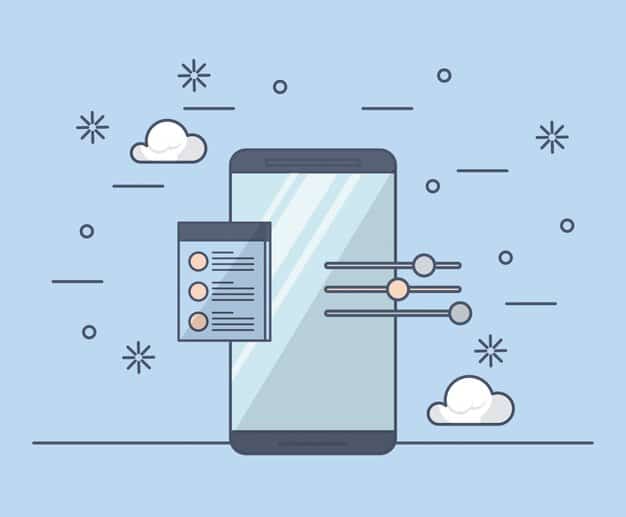Mobile Device Security: Protecting Your Company’s Data

Mobile device security is crucial for protecting company data on employee smartphones, requiring a comprehensive approach encompassing policies, technology, and employee training to mitigate risks effectively.
In today’s interconnected world, mobile devices are essential tools for business, but they also present significant security risks. Mobile device security: protecting your company’s data on employee smartphones is no longer optional; it’s a necessity.
Understanding the Risks of Mobile Devices
Mobile devices, while increasing productivity and flexibility, open up potential vulnerabilities that malicious actors could exploit. It’s crucial to acknowledge the landscape of threats when discussing mobile device security.
Common Mobile Security Threats
One of the initial steps in securing mobile devices is fully understanding the threats these devices face. A myriad of issues, spanning from basic vulnerabilities to more sophisticated forms of attack, endanger mobile devices.
- Phishing Attacks: Phishing attacks are still common and effective, because many people will follow the steps in a phishing email.
- Malware Infections: Downloading malicious files or apps leads to malware infections on devices.
- Unsecured Wi-Fi: Joining public Wi-Fi networks without encryption exposes data to interception.

These threats are constantly evolving, requiring constant updates both to security protocols and employee education.
Developing a Mobile Device Security Policy
One of the first steps in establishing a robust security posture is a well-defined mobile device security policy. This policy should clearly communicate the expectations, responsibilities, and guidelines for mobile device use within the company.
Key Components of a Security Policy
A mobile security policy needs to be thorough, addressing all the crucial elements of securing mobile devices. It serves as a roadmap for employees, providing guidance on how to handle devices and data securely.
- Password Requirements: Enforce strong passwords or biometric authentication.
- Data Encryption: Mandate encryption for data at rest and in transit.
- App Installation Guidelines: Establish guidelines for installing apps from trusted sources.
Policies are only effective if they are communicated clearly and regularly reinforced through training and reminders.
Implementing Mobile Device Management (MDM)
Mobile Device Management (MDM) tools are essential for managing and securing mobile devices that access company data. MDM provides administrators with the ability to remotely monitor, manage, and secure devices.
Benefits of MDM Solutions
An MDM solution provides several tangible benefits that contribute directly to an organization’s security posture. It allows for centralized control and visibility over the mobile device fleet.
- Remote Device Configuration: Easily configure device settings and security policies from a central console.
- App Management: Control which apps can be installed on devices.
- Remote Wipe: Remotely wipe data from lost or stolen devices to prevent unauthorized access.
By incorporating Mobile Device Management, companies can enforce security measures and ensure compliance across mobile devices, regardless of their location.
Securing BYOD (Bring Your Own Device) Environments
The Bring Your Own Device (BYOD) approach enables employees to use their personal mobile devices for work purposes. While BYOD can increase employee satisfaction and productivity, handling security requires careful planning and execution.
Balancing corporate security with employee privacy is crucial in BYOD environments. To do this, implement containerization and app wrapping to keep corporate data separate from personal data.

BYOD Best Practices
When implementing BYOD, consider these best practices for maintaining security:
Enrolling BYOD devices into a Mobile Device Management (MDM) solution centralizes management and improves security. Additionally, regularly monitor and audit devices to identify and address potential security issues.
| Key Point | Brief Description |
|---|---|
| 📱Risk Understanding | Identify common threats like phishing and malware. |
| 💼 Security Policies | Establish password and data encryption protocols. |
| 🛡️ Mobile Management | Use MDM for remote monitoring and security controls. |
| 🏢 BYOD Security | Implement containerization to segregate personal/work data. |
FAQ
▼
Mobile device security involves protecting smartphones and tablets from threats like malware, phishing, and data breaches, safeguarding sensitive work environments.
▼
It’s important because unsecured mobile devices can expose sensitive company data to unauthorized access, leading to financial losses and reputational damage, so protect your data.
▼
Key components include password requirements, data encryption, app installation guidelines, and procedures for lost or stolen devices, so a mobile security policy is a good approach.
▼
MDM enables remote monitoring, management, and securing of devices, allowing for quick responses to security incidents and ensuring compliance with policies within your workplace.
▼
Best practices include MDM enrollment, containerization, regular monitoring and auditing, and clear communication of acceptable use policies, which can help with productivity overall.
Conclusion
In conclusion, mobile device security: protecting your company’s data on employee smartphones is a critical undertaking that combines robust policies, advanced technology, and consistent employee education. By taking a proactive and comprehensive approach, organizations can protect their valuable data assets in an ever-evolving threat landscape.





